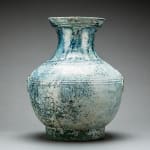Lead-Glazed Jar with Dish-shaped Mouth, 100 BCE - 8 CE
Terracotta
height 33.7 cm
height 13 1/4 in
height 13 1/4 in
LA.523
Further images
Reddish earthenware globular body with a plain band around the shoulder and green lead glaze throughout.Similar in shape to a bronze hu (to which it owes its shape), these lead...
Reddish earthenware globular body with a plain band around the shoulder and green lead glaze throughout.Similar in shape to a bronze hu (to which it owes its shape), these lead glazed ceramic versions emerged in Shaanxi during the second century BCE. They were executed in diverse shapes, the most luxurious examples having moulded low-relief friezes. The two animal masks with rings (pushou xianhuan) here serving as decorative handles, reflect the style of contemporary door-knockers.
Examples of this type of globular jar with flat bottom have been found in late Western Han tombs in Shaanxi and Henan. Although a number of scholars have proposed that lead-flux glazes ultimately could have derived from the West, their emergence was probably encouraged by Chinese Daoist practice. In fact, Daoist alchemists in their search for immortality had since the Eastern Zhou period developed formulas involving the use of smelted lead, which were believed to produce elixirs able to transform the body if swallowed. The result of melting lead with sand and clay during the preparation of these immortality-granting potions was likely to have been noticed by the potters, who eventually adapted the process for glazing.
For comparable examples see:
Kaogu 1982.3: 226;
Kaogu xuebao 1991.2: 245-6;
Examples of this type of globular jar with flat bottom have been found in late Western Han tombs in Shaanxi and Henan. Although a number of scholars have proposed that lead-flux glazes ultimately could have derived from the West, their emergence was probably encouraged by Chinese Daoist practice. In fact, Daoist alchemists in their search for immortality had since the Eastern Zhou period developed formulas involving the use of smelted lead, which were believed to produce elixirs able to transform the body if swallowed. The result of melting lead with sand and clay during the preparation of these immortality-granting potions was likely to have been noticed by the potters, who eventually adapted the process for glazing.
For comparable examples see:
Kaogu 1982.3: 226;
Kaogu xuebao 1991.2: 245-6;







